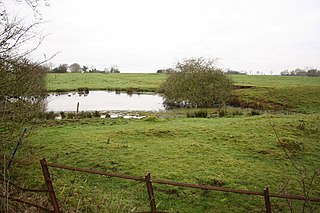Related Research Articles
A double monastery is a monastery combining separate communities of monks and of nuns, joined in one institution to share one church and other facilities. The practice is believed to have started in the East at the dawn of monasticism. It is considered more common in the monasticism of Eastern Christianity, where it is traceable to the 4th century. In the West the establishment of double monasteries became popular after Columbanus and sprang up in Gaul and in Anglo-Saxon England. Double monasteries were forbidden by the Second Council of Nicaea in 787, though it took many years for the decree to be enforced. Double monasteries were revived again after the 12th century in a significantly different way when a number of religious houses were established on this pattern among Benedictines and possibly the Dominicans. The 14th-century Bridgittines were purposely founded using this form of community.

Aberconwy Abbey was a Cistercian foundation at Conwy, later transferred to Maenan near Llanrwst, and in the 13th century was the most important abbey in the north of Wales.

St. Anselm's Abbey is a Benedictine Abbey located at 4501 South Dakota Avenue, N.E., in Washington, D.C.. It operates the boys' middle and high school St. Anselm's Abbey School, which was ranked by the Washington Post as the most challenging in Washington, D.C., and as the most challenging private high school in the U.S.

Bardney Abbey in Lincolnshire, England, was a Benedictine monastery founded in 697 by King Æthelred of Mercia, who was to become the first abbot. The monastery was supposedly destroyed during a Danish raid in 869. In 1087, the site was refounded as a priory, by Gilbert de Gant, Earl of Lincoln, and it regained status as an abbey in 1115.

Hatfield Broad Oak Priory, or Hatfield Regis Priory, is a former Benedictine priory in Hatfield Broad Oak, Essex, England. Founded by 1139, it was dissolved in 1536 as part of Henry VIII's dissolution of the monasteries.
Pontefract Priory was a Cluniac monastery dedicated to St. John the Evangelist, founded about 1090 by Robert de Lacy, 2nd Baron of Pontefract, and located in Yorkshire, England. It existed until the dissolution of the monasteries. The Church and buildings have been completely destroyed, but the site is still indicated by the name of Monk-hill.

Bullington Priory was a priory in Bullington, Lincolnshire, England.
Cammeringham Priory was a priory in Cammeringham, Lincolnshire, England.

Deeping St James Priory was a priory in Deeping St James, Lincolnshire, England. In 1139 Baldwin Fitz Gilbert established the Benedictine Priory of Saint James at Deeping as a cell of Thorney Abbey. The cell was dissolved at the surrender of Thorney in 1539. The priory church remains as the Church of England parish church of Deeping St James and is a Grade I listed building.
Freiston Priory was a Benedictine cell of Crowland Abbey founded in 1114, and became a priory soon afterwards. It was Dissolved in 1539 and was located in Freiston, Lincolnshire, England.
Great Limber Preceptory, Limber Magna was a Camera (farm) of the Knights Templar and later the Knights Hospitaller in the village of Great Limber, Lincolnshire, England.
Haugham Priory was a Benedictine priory in Lincolnshire, England.

St. Mary Magdalen was a Benedictine priory in Lincoln, England. Along with Sandtoft Priory and Hanes Cell, it was a Lincolnshire cell of St Mary's Abbey in York, England. A surviving building, once owned by the priory, is Monks' Abbey, Lincoln.

Minting Priory was a priory in Minting, Lincolnshire, England.

Nuncotham Priory was a priory of Cistercian nuns in Brocklesby, Lincolnshire, England.
Skendleby Priory was a priory in the village of Skendleby, Lincolnshire, England.
Hagnaby Abbey was an abbey and former priory in Hagnaby, Lincolnshire, England.

Louth Park Abbey was a Cistercian abbey in Lincolnshire, England. It was founded in 1139 by the Bishop Alexander of Lincoln as a daughter-house of Fountains Abbey, Yorkshire.

Newsham Abbey was an abbey in Newsham, a small hamlet north of Brocklesby village in Lincolnshire, England. Founded by Peter of Gousla in 1143, Newsham was a daughter house of the Abbey of Licques, near Calais, and the first Premonstratensian house established in England.
Roger Norreis was Abbot of Evesham in England. He was a controversial figure, installed in several offices against opposition. In his appointment to Evesham he was accused of immoral behaviour and failing to follow monastic rules. In 1202 Norreis became embroiled in a dispute with his monks and his episcopal superior the Bishop of Worcester; litigation and argumentation lasted until his deposition in 1213. He then was appointed prior of a subsidiary monastic house of Evesham but was deposed within months, then re-appointed to the office five years later.
References
- ↑ "Covenham Priory". Alien Houses. Victoria County History. Retrieved 3 August 2011.
- ↑ Historic England. "Covenham Priory (354719)". PastScape. Retrieved 3 August 2011.
Coordinates: 53°26′25″N0°02′10″E / 53.440252°N 0.036210°E
| This article about a Lincolnshire building or structure is a stub. You can help Wikipedia by expanding it. |
| | This article about a British Christian monastery, abbey, priory or other religious house is a stub. You can help Wikipedia by expanding it. |

